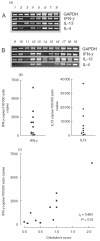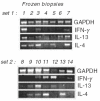The Th1/Th2 cytokine balance changes with the progress of the immunopathological lesion of Sjogren's syndrome
- PMID: 12067313
- PMCID: PMC1906267
- DOI: 10.1046/j.1365-2249.2002.01869.x
The Th1/Th2 cytokine balance changes with the progress of the immunopathological lesion of Sjogren's syndrome
Abstract
Expression of type-1 and type-2 cytokines at the mRNA level in labial salivary glands (LSG) of patients with Sjogren's syndrome (SS), as reported by several groups, have generated conflicting results. In the present study we have directly examined the production of IL-4, IL-13 and IFN-gamma by lymphocytes infiltrating the LSG of 44 consecutive patients referred for SS evaluation. Cytokines production was evaluated following in vitro culture of LSG in the presence of IL-2. IFN-gamma and IL-13 were detected in the majority of SN (24/44 and 26/44, respectively) while IL-4 was present in 5/44 SN. The presence of IFN-gamma was significantly higher in SS patients, as opposed to patients who did not fulfil the criteria for SS (P < 0.01). In addition, almost all cultured lymphocytes expressed mRNA for IFN-gamma (17/19 cultures) and IL-13 (18/19) while IL-4 mRNA was also expressed at high frequency (14/19 cultures). Interestingly, the IFN-gamma mRNA copies in cultured lymphocytes correlated significantly with the intensity of lymphocytic infiltration as evaluated by Chisholm's score (P < 0.01). Furthermore, RT-PCR of RNA extracted from whole LSG from 14 SS patients also demonstrated the presence of all cytokines in the majority of the cases and the prevalence of IFN-gamma in LSG with high-grade infiltration. Because IL-13 was produced by the majority of the cultured LSG, IgE production was also evaluated. Interestingly, IgE was detected in 21/44 LSG culture SN and mainly in those biopsies that had Chisholm's score less than 0.5 (P < 0.05). We conclude that lymphocytes infiltrating the LSG are capable of producing both Th1 and Th2 cytokines and that the balance between them shifts in favour of Th1 in LSG with high infiltration score and in patients with SS.
Figures





References
-
- Moutsopoulos HM. Sjogren’s syndrome. In: Fauci AS, Braunwald E, Isselbacher KG, et al., editors. Harrison’s principles of internal medicine. 14. New York: McGraw-Hill; 1998. pp. 1901–4.
-
- Fox RI, Kang HI. Pathogenesis of Sjogren’s syndrome. Rheum Dis Clin North Am. 1992;18:517–38. - PubMed
-
- Skopouli FN, Fox PC, Galanopoulou V, Atkinson JC, Jaffe ES, Moutsopoulos HM. T cell subpopulations in the labial minor salivary gland histopathologic lesion of Sjogren’s syndrome. J Rheumatol. 1991;18:210–4. - PubMed
-
- Kong L, Ogawa N, Nakabayashi T, et al. Fas and Fas ligand expression in the salivary glands of patients with primary Sjogren’s syndrome. Arthritis Rheum. 1997;40:87–97. - PubMed
Publication types
MeSH terms
Substances
LinkOut - more resources
Full Text Sources
Medical

